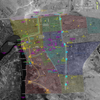If Six Days in Fallujah is ever in production again, the following information won’t spoil the game for you. All the material used here is public knowledge gathered through printed resources and online sources. The magic of the experience was how this information was presented (along with the realistic tactics, honest language, and destruction).
Any new development will refactor all the material to suit current needs, scope, and climate.

Points of Reference
To recreate the real events for Six Days in Fallujah (SDIF) the team needed to know as much as they could about the Battle. Early on, several Marines worked directly with the team to share as much information as they could. Later in 2009, more Marines contributed further to the authenticity. Captain Read Omohundro’s (U.S. Marine Corps, retired) guidance was invaluable to the project.
When I joined the project earlier, it already had a wealth of raw information, such as which Marine company traveled which Phase Line and how larger events affect the House-to-House orders. I did my own research and found even more material as well as locating several key locations based on different written accounts.
Piecing together this information was more challenging a decade ago than it would be now. The Battle was only a handful of years old and fewer things had been contributed to the internet or print beyond news highlights.

Fig 1: Marine activity and landmarks

Fig 2: Insurgent activity
With the physical locations known, the next step was determining which Marine accounts and news reports had a story to tell at each point-of-interest. Several books provided vivid details of victory, tragedy, and fortitude. Some of those were:
That information became the basis for missions in SDIF.
 Fig 3: A sample of accounts in the Battle.
Fig 3: A sample of accounts in the Battle.
Campaign History
As with any game production, the original goals evolve over time. These typically involve some form of scope-reduction to help focus the project and elevate quality over quantity. Over the course of four years, SDIF went from 30 missions to 8.
2005 Version
The original campaign for SDIF had 5 missions for each of the 6 Days — 30 levels total. The game world was based on the actual city, so each gamespace was huge, at roughly 40,000 game units (most tactical shooters feature less than half of that).
Vehicles were the remedy for this scale. My impression was a game that rivaled GTA in scope and complexity.
2007 Version
Reality checked in and the campaign was reduced to 19 missions. With the exception of the 1st Day, each Day now featured 3 missions each. Vehicles were relegated to special cases or as backdrop. No freeform driving allowed.
The gamespaces themselves were reduced in size as well, shrinking down to a manageable 12-20,000 game units (the size of an Uncharted Level if folded into a sandbox). This change allowed the team to have more control with moment-to-moment action. At the original scale, the only way to populate non-critical areas would’ve been procedurally, which risked being repetitive and uninspiring.
2008 Version
The third iteration occurred when the project moved to Raleigh. The total missions were only reduced by one, but the scale of each gamespace was downsized to 10-12,000 game units (somewhere in the ballpark of a Gears of War level). The change was due to technical reasons. With all of the sheer destruction we were estimating, anything larger wouldn’t fit in tech performance or memory.
2009-Q1 Version
When Konami entered the picture in early 2009, the project was now bound to a schedule. To ship in 2010, SDIF was reduced to 12 levels. Their physical size remained the same. Each Day had 1-3 missions. Each mission was to be introduced and/or followed by an interview with a Marine who was there.
Previously scope-reduction hadn't disrupted the highlights, events, or people met in the game. During this last change however, I had to start picking the best events and put aside less dynamic ones. Like previous versions, the experience featured 2 Fire Teams (mixed with real Marines) the player switched to depending on the location and event.
 Fig 4: Twelve Konami Mission Locations
Fig 4: Twelve Konami Mission Locations
Train Station + HH
Jolan Entry
Culture Center
Jolan Park + HH
Jolan Pizza Slice
Jolan Market
Candy Store + HH
Resala Cemetery
Nazal Clearing
Nazal Besieged + HH
Phase Line Henry
Hell House



































